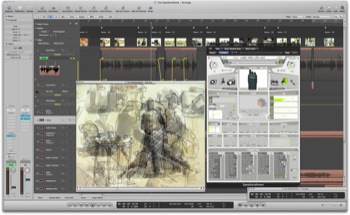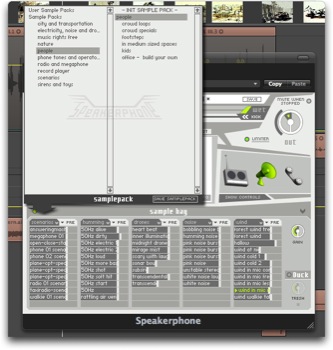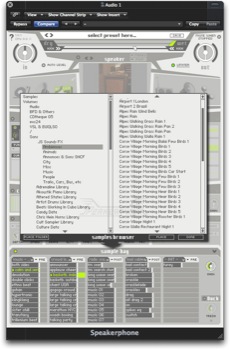Have you ever dreamed of a speaker simulator, that would allow you to integrate any audio file into a totally programmable background environment, from a wood case to an imaginary spatial airport full of transit passengers? If so, Audio Ease has made your dreams come true with Speakerphone. From post-production to music production, a complete review.
Huge content
 |
Speakerphone is a Mac and Windows plug-in, for AU, VST, MAS and RTAS compatible host applications. It’s available for download and registered users can order a backup DVD ($30/30€). The plug-in is authorized by challenge-response or iLok and comes with a 5 GB sample library (more information here). Note that TDM format is not available. Does it mean something is changing, due to recent computer processing power? Will every manufacturer change to native formats only? The future will tell…
Let’s see in a few words how Speakerphone works: a mono or stereo audiofile goes through a speaker simulator, then through a convolution reverb, some effects and finally it can be mixed with a complete background environment.
With Altiverb, Audio Ease has proven itself as one of the greatest convolution experts. Naturally, this technology is also used in Speakerphone to make IRs of 270 speakers: a really nice and complete collection, including record players, toys, TV, computers, phones, radios, gramophones, headphones, bass and guitar amps, walkies-talkies and other goodies.
The 30 different reverbs are mostly coming from Altiverb. You’ll also find 10 effect modules: Distortion, EQ, Crush, Gate, Compressor, Phono, Mod, Codec, Delay and Tuning. Then you can load Sample Packs in the Sample Bay, choosing between various ambiences (cities, transports, nature, etc.), sounds FX and foleys (phone rings, electronics, human sounds…), some copyright free music or your own samples, FX and music, looped or not.
Menu & modules
 |
At first sight, the GUI is a bit puzzling. The lack of contrast and the tiny inscriptions might be problematic if you work at a reasonable distance from your monitor. Fortunately, a pop-up with a green background indicates the name and the value of a parameter when mousing over it. It would be better if it was bigger…
However, the different sections/modules are placed according to the signal path. There are two menus, one for global help when hovering the mouse cursor over the plug (activation by the “question mark” sign), the other gives information on the speakers, both of which are very helpful. Another good point: you can use the mouse wheel to adjust values or scroll in (almost) all of the plug-in areas.
Speakerphone is broken down into three parts: speakers simulations, effects and samples. In the upper section you’ll find the presets bar, giving access to up to 500 carefully tailored settings. On the left there is the Gain knob and its Auto Level, which ensures that the input level is always optimized. On the right are the Out level and its limiter.
Then you’ll find the speaker section which has, like each module of the plug, its own bypass. Hence you may choose to use only reverb or effects, or activate a module when required. Any Speakerphone function and parameter can be attached to a MIDI controller by right-clicking (or ctrl-clicking) on it, which opens a MIDI Learn/Reset menu.
Six icons are shortcuts to the speakers classification and a central monitor shows a picture of the selected speaker. You can choose between mono and stereo, pre- and post-FX. Just below there’s two Show/Hide control tabs.
Audio Ease has implemented a nice function, Kick. Below the Dry/Wet slider, there’s another one being flanked by two arrows: when you click on these arrows, the slider will move from Dry to Wet (or vice-versa) according to a period of time between 0.10 and 30 seconds (by intervals of 0.02 seconds when pressing Alt). It’s not only a static balancing between Dry and Wet signals, but kind of dynamic modification of each module independently. This is a clever function, allowing the user to perfectly simulate changes like someone walking from one room to another, or two people talking on either end of a phone. The required precision can be achieved by automating the function.
Effects galore
 |
The FX section is rather complete. Thus, there’s a lot of EQing possibilities: two shelving EQ (Low, High), two resonating filters (Hi and LowPass) and two parametric with Q, the settings of each EQ being automatable. You can independently activate any EQ simply by clicking on its name. There’s also a good compressor, with all the usual parameters, a ratio ranging from 1:1 to 100:1 and an ensemble of presets. To stay in the dynamic processors side, you’ll find a Gate with threshold and release that can work either in ducking mode (-20dB) or in Mute mode (-120dB).
Time-based effects are represented by the reverb (see below) and a delay, mono or stereo, with separate or linked channel settings, Feedback, bi-mode filer, synchro to host and Mix parameters. Reverb IRs allow you to tailor every possible space, from wood case to forest, from a real plate to its version by Lexicon, from the inside of a train wagon to a little car, to reproduce sounds coming from another room, door closed, or open, etc. Some come from Altiverb, others were specially made for the plug-in. Audio Ease has such know-how in the IR domain that there’s no need to detail the qualities of those included in Speakerphone.
Mod completes the FX section, with the usual tremolo, chorus, flanger, phaser and vibrato. It has minimal settings (Depth, Speed), hence no Regen, Width or other refinements, but Mod is tempo sync capable. Most of these effects are good, but are not able to compete with dedicated plug-ins. Only the vibrato could be a bit difficult to use in a musical context but can do wonders in sound design applications.
Sonic destruction
 |
Let’s see the sonic destruction processors: firstly, Distortion offers ten models, ranging from amp modelisations to waveshapers. The effect also includes a lowpass filter with resonance, a parametric EQ, two Gain (pre- and post-) and a Mix knob. You can command curve and distortion ratio with Curve, via an X/Y screen. This Distortion section gives very good results when used together with amp IRs.
Then Crush also offers an X/Y screen (bit reduction and sampling rate), and is the perfect tool to emulate phones or walkies sonic degradations. Above all you can use it with Codec, which reproduces the data compression codecs used in cell phones, with sampling rate reduction and connection interferences (Quality). You can also build robot voices by using fixed pitch settings, and/or play pitched phrases by MIDI notes.
With Phono, you’ll find all the artifacts of your record player, in 33, 45 or 78 RPM. There are two parameters modifying the pitch, one emulating an off-center hole (Wow), the other a warped record (Curve). Ticks adds rumble, 50 Hz noise, scratches, light filtering, dust noise and has a master Gain. It would have been nice to have had an independent level for both rumble and noises and another for scratches, all the more so as 50Hz and others are available as separate samples in the Sample Bay.
The last effect, the funny Tuning, simulates artifacts and interferences when you’re dialing for radio stations on an analog radio receiver. Another X/Y screen gives you control over rate and frequency: you can choose between mono and stereo, and you can select FM and AM behaviors among 16 presets, some including music or conversations to add more realism.
Samples & sounds
|
All the files of the Sample part are very good quality (between 16bit/44.1kHz and 24bit/48kHz) and have an appreciable duration, thus avoiding the sensation of a loop playing again and again. For instance, the ambience Heli Star Fly Land lasts 6.30 minutes…
The Sample Bay is divided into five columns, and each one can be loaded with 12 samples (a Sample Pack). These samples can be triggered by the mouse, via host MIDI automation or by a MIDI keyboard. They can even be played all together.
There’s 45 factory Sample Packs, classified into 10 categories. The volume of each sample can be adjusted by moving the horizontal fader, and each column of samples can be assigned pre- or post-effect. Too bad that mousewheel recognition isn’t implemented in order to adjust volume, because the horizontal cursor is so tiny that you will often click outside of it, launching (or stopping) another sample.
Audio Ease added two great options : you can import your own samples (just drag’n’drop them in a column) and you can export Speakerphone’s (Alt-click and drag’n’drop). The ambiences and noises are either looped or one-shot.
As the selection is wide, you can hardly find missing ambiences. If you want to mix a dialog between two people in a stadium by the seaside with their neighbor listening to some music on his iPod, mixed with an announcement on the stadium PA system, with some sirens and a helicopter in the distance and the crowd reacting to the match, it will definitely be an extreme situation (I pity the mix engineer!), but it’s possible.
 |
As you can see, there’s almost every option to produce every background. And if each effect taken separately isn’t the best in its category, it’s the mix of each module that makes the Speakerphone sound, and what a sound! Let’s hear some examples. We’ll use this speakerin voice and place it in various situations. First, let’s choose a speaker in the Megaphones category, a Jensen Hypex. Then select a reverb, the Station Hall, and reduce a bit the Decay, and increase the Dry level. Then we’ll add a delay, in order to simulate the several speakers of a station hall, and an announce ringtone from the Sirens Sample Pack. We’ll end by adding crowd, footsteps and music, all coming from the sample library, and by adjusting the respective levels..
With the same voice, we can do something completely different (the text isn’t appropriate anymore, but it doesn’t matter). Such as an announcement broadcasted on the car radio of a car traveling at night under a storm, hence some interferences , or make it a call in the headphones of a helicopter pilot . Speakerphone does the job perfectly, and the import/export functions allow a great number of mix and sound design possibilities. For example, you can compensate for the lack of integrated Pan. One of the best uses of Speakerphone is to insert it on a Bus, which allows you to send several audio files in the same environment, while keeping precise control over their volume and pan.
Speakerphone is also amazing regarding its guitar and bass amp IRs. Here we have a very basic guitar riff (thanks to Mathias Desmier). We played it through a 1963 Vox AC30 IR, and a 1966 Sears Silvertone.. If time-based, and mod effects aren’t as good as dedicated plugs can be, the association of the Distortion module, the amp IRs and the convolution reverbs probably give the best amp simulations I’ve heard.
In conclusion
 |
Speakerphone answers a lot of sound design issues. Just by using presets and a little tweaking, you’ll quickly find an appropriate solution, that perfectly covers a given sound design need. Starting from scratch is easy as well. The nearly full automation is also of a great help to either avoid static sound, or to dynamically change your settings, according to what’s occurring on the screen.
Of course, Speakerphone isn’t meant to replace a full sound design creation. But if you need to deliver professional work in a short delay (isn’t it always the case?), I doubt anyone will ever notice you’ve only used one tool. Regarding the sample library, it is as good as other similar products (and even better than some), and it could be sold alone at the same price as these pro libraries. Which would mean a high price.
Speakerphone also delivers excellent results as a plug-in for instruments, lead or harmony vocals, with its combination of amp and reverb IRs. Audio Ease has also programmed a preset ensemble named Experimental Presets, which demonstrates all the creative power of the plug.
There’s also some disadvantages, like the lack of individual pan in the Sample Bay, as well as a lack of volume automation. But it’s not that important, since you can export samples into your host audio tracks. And if you can’t find a particular sound, you’ll can import it from your personal collection in order to apply the same effects.
There are practically no bugs, with the exception of a rare graphic one in Logic, where the plug interface dissociates itself from the Logic plug’s black frame. I haven’t figured out if it’s Logic, Tiger or Leopard related. Another minor problem: the de-installer doesn’t work. Audio Ease is working on an update that will fix both issues.
Once again, Audio Ease has chosen to release an original plug that perfectly fulfils its objectives, rather than proposing an umpteenth and superfluous version of a well-known effect. Speakerphone is essential for working on movies, ads, clips or anything visual and is also very convincing in a musical context.
[+] All-in-one concept
[+] Sound quality
[+] Wonderful speaker IRs
[+] Reverbs come from Altiverb
[+] Qualities of ambiences (sound, length)
[+] Numerous effects, with unusual ones.
[+] Ease of use
[+] Presets
[+] Automation (nearly complete)
[+] Midi Learn
[+] For sound design as well as for music
[+] Sample Export/Import
[+] Mono-Stereo
[-] GUI sometimes hard to read
[-] No internal pan for ambiences and sound effects
[-] No independent volume automation in Sample Bay
[-] An occasional graphic bug in Logic
